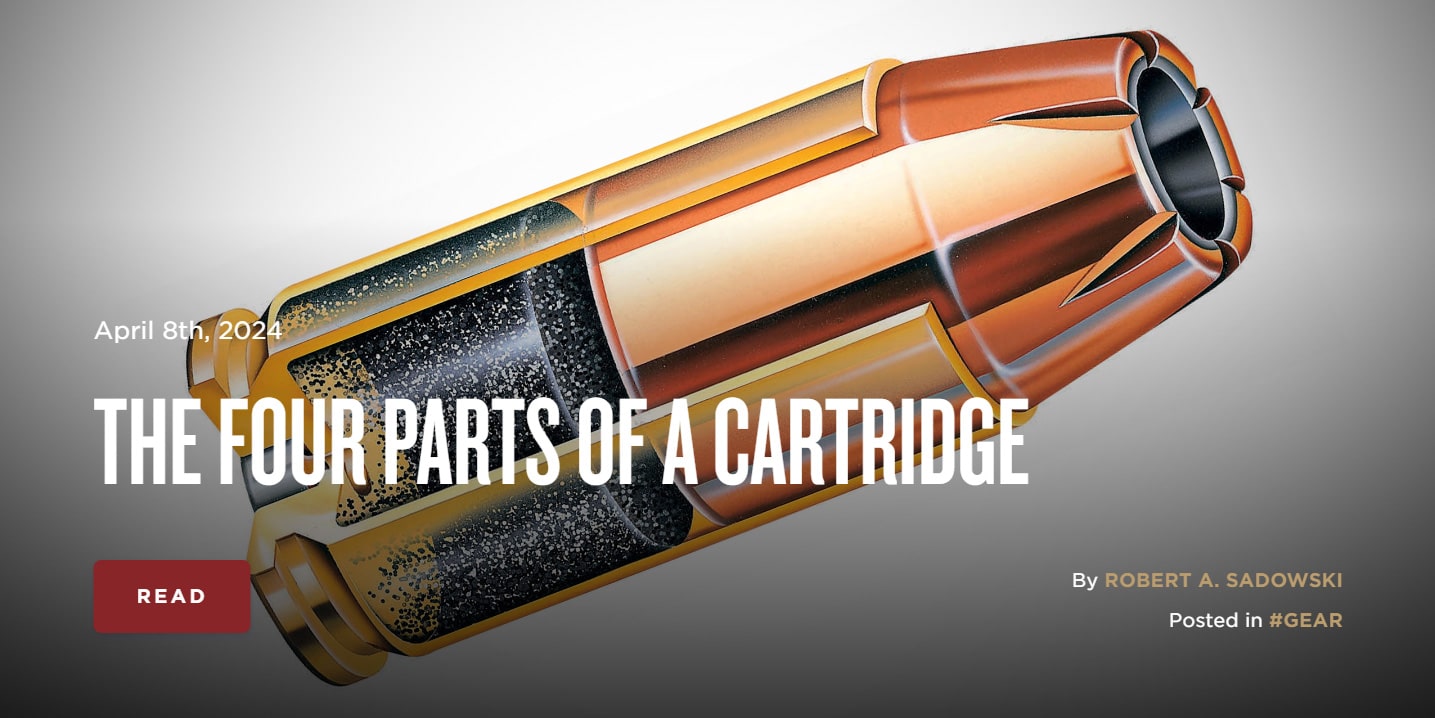Hello all, here is today's article posted on TheArmoryLife.com. It is titled “The Four Parts of a Cartridge” and can be found at https://www.thearmorylife.com/four-parts-of-a-cartridge/.



A "grain" is a measure of weight (mass). Both powder and bullets are often measured in grains. Technically, you could measure the weight of anything in grains.Great article for the ones like me who really don't know about gun mechanics but just loves to shoot, and also in my case of Army service, (first time I ever shot a gun) "they put a gun in my hand, taught me how to shoot, and I was good at it". lol
I learned something... for some reason I always thought the "grain" was the weight of the gun powder in the cartridge, not the "bullet" or projectile.
Q. thou:
"A good approach is to choose a bullet based on how it cycles in your gun. The 115-gr. bullets will have a higher velocity, while a heavier bullet like a 147-grain bullet has reduced velocity but more impact on target."
I also thought a higher grain, meant more gunpwder to expel the projectile. So always thought bigger weight was better... but is the above saying that the lower grain has more velocity? And is more velocity what we want?
Thanks for the lessons.
The projectile and the powder charge are both defined by weight in grains. Less bullet weight typically equals higher velocity all other things being equal. Higher powder charge weight will also increase velocity. However, those two variables must be proportional and work together. Too much powder along with too heavy a bullet will usually end in either an exploded barrel, cylinder, or the shooter's hand with maybe a lost eye, or worse. Too little powder charge for any given bullet weight will typically result in a squib load.Great article for the ones like me who really don't know about gun mechanics but just loves to shoot, and also in my case of Army service, (first time I ever shot a gun) "they put a gun in my hand, taught me how to shoot, and I was good at it". lol
I learned something... for some reason I always thought the "grain" was the weight of the gun powder in the cartridge, not the "bullet" or projectile.
Q. thou:
"A good approach is to choose a bullet based on how it cycles in your gun. The 115-gr. bullets will have a higher velocity, while a heavier bullet like a 147-grain bullet has reduced velocity but more impact on target."
I also thought a higher grain, meant more gunpwder to expel the projectile. So always thought bigger weight was better... but is the above saying that the lower grain has more velocity? And is more velocity what we want?
Thanks for the lessons.
You're getting into the world of exterior ballistics now with questions requiring a lot more explaining than can be done here. Typically factory, and even re-loaded lighter weight bullets will be faster than heavier ones, but not always. Heavier bullets are typically slower, but again not always a given.And what does velocity speed per second on the side of the box mean? I mean I know the definition. Just wondering how/what is the better speed for a weapon?
Hi Magnum50: It looks like BSD and JumpinJoe have already provided you will good answers. Yes, generally speaking, a heavier grain bullet will have less velocity because there is less space in the case for powder. With smaller grain bullets there is more space for powder. There's an expression: Speed Kills. Roy Weatherby was proponent of more speed in hunting calibers. The idea with an EDC gun is you want a load that performs in your gun, cycles, hit to point of aim, etc. Ammo boxes are marked with the muzzle velocity which is factory test data. In real life, most ammo is slightly less than what's printed on the box. Hollow point bullets need to reach a specific speed to expand properly and ammo manufacturers know this, that's why some of them produce ammo for short barrel handguns. Short barrel handguns do not produce muzzle velocities as high as say a 4-inch barrel pistol. I hope this answers your questions.And what does velocity speed per second on the side of the box mean? I mean I know the definition. Just wondering how/what is the better speed for a weapon?
Robert, thanks for chiming in. We appreciate it when the authors follow up with the readers!Hi Magnum50: It looks like BSD and JumpinJoe have already provided you will good answers. Yes, generally speaking, a heavier grain bullet will have less velocity because there is less space in the case for powder. With smaller grain bullets there is more space for powder. There's an expression: Speed Kills. Roy Weatherby was proponent of more speed in hunting calibers. The idea with an EDC gun is you want a load that performs in your gun, cycles, hit to point of aim, etc. Ammo boxes are marked with the muzzle velocity which is factory test data. In real life, most ammo is slightly less than what's printed on the box. Hollow point bullets need to reach a specific speed to expand properly and ammo manufacturers know this, that's why some of them produce ammo for short barrel handguns. Short barrel handguns do not produce muzzle velocities as high as say a 4-inch barrel pistol. I hope this answers your questions.
